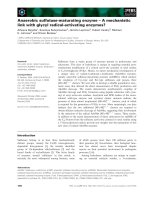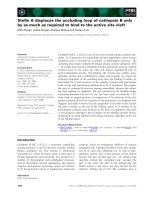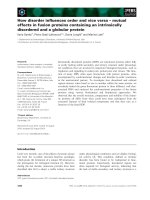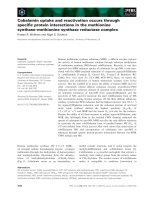Tài liệu Báo cáo khoa học: "HOW DO WE COUNT? THE PROBLEM OF TAGGING PHRASAL VERBS IN PARTS" docx
Bạn đang xem bản rút gọn của tài liệu. Xem và tải ngay bản đầy đủ của tài liệu tại đây (258.83 KB, 3 trang )
HOW DO WE COUNT?
THE PROBLEM OF TAGGING PHRASAL VERBS IN PARTS
Nava A. Shaked
The Graduate School and University Center
The City University of New York
33 West 42nd Street. New York, NY 10036
ABSTRACT
This paper examines the current performance of the
stochastic tagger PARTS (Church 88) in handling phrasal
verbs, describes a problem that arises from the statis-
tical model used, and suggests a way to improve the
tagger's performance. The solution involves a change
in the definition of what counts as a word for the pur-
pose of tagging phrasal verbs.
1. INTRODUCTION
Statistical taggers are commonly used to preprocess
natural language. Operations like parsing, information
retrieval, machine translation, and so on, are facilitated
by having as input a text tagged with a part of speech
label for each lexical item. In order to be useful, a tag-
ger must be accurate as well as efficient. The claim
among researchers advocating the use of statistics for
NLP (e.g. Marcus et
al.
92) is that taggers are routinely
correct about 95% of the time. The 5% error rate is not
perceived as a problem mainly because human taggers
disagree or make mistakes at approximately the same
rate. On the other hand, even a 5% error rate can cause
a much higher rate of mistakes later in processing if
the mistake falls on a key element that is crucial to the
correct analysis of the whole sentence. One example
is the phrasal verb construction (e.g.
gun down, back
off). An error in tagging this two element sequence will
cause the analysis of the entire sentence to be faulty.
An analysis of the errors made by the stochastic tag-
ger PARTS (Church 88) reveals that phrasal verbs do
indeed constitute a problem for the model.
2. PHRASAL VERBS
The basic assumption underlying the stochastic pro-
cess is the notion of independence. Words are defined
as units separated by spaces and then undergo statis-
tical approximations. As a result the elements of a
phrasal verb are treated as two individual words, each
with its own lexical probability (i.e. the probability of
observing part of speech i given word j). An interesting
pattern emerges when we examine the errors involving
phrasal verbs. A phrasal verb such as
sum up
will be
tagged by PARTS as noun + preposition instead of
verb + particle. This error influences the tagging of
other words in the sentence as well. One typical error
is found in infinitive constructions, where a phrase like
to gun down
is tagged as INTO NOUN IN (a prepo-
sitional 'to' followed by a noun followed by another
preposition). Words like
gun, back, and sum,
in iso-
lation, have a very high probability of being nouns a.s
opposed to verbs, which results in the misclassification
described above. However, when these words are fol-
lowed by a particle, they are usually verbs, and in the
infinitive construction, always verbs.
2.1. THE HYPOTHESIS
Tile error appears to follow froln the operation of the
stochastic process itself. In a trigram model the proba-
bility of each word is calculated by taking into consider-
ation two elements: the lexical probability (probability
of the word bearing a certain tag) and the contextual
probability (probability of a word bearing a certain tag
given two previous parts of speech). As a result, if an
element has a very high lexical probability of being a
noun
(gun
is a noun in 99 out of 102 occurrences in the
Brown Corpus), it will not only influence but will ac-
tually override the contextual probability, which might
suggest a different assignment. In the case of
to gun
down
the ambiguity of to is enhanced by the ambiguity
of
gun,
and a mistake in tagging
gun
will automatically
lead to an incorrect tagging of
to
as a preposition.
It follows that the tagger should perform poorly on
289
phrasal verbs in those cases where the ambiguous el-
ement occurs much more frequenty as a noun (or any
other element that is not a verb).The tagger will expe-
rience fewer problems handling this construction when
the ambiguous element is a verb in the vast majority of
instances. If this is true, the model should be changed
to take into consideration the dependency between the
verb and the particle in order to optimize the perfor-
mance of the tagger.
3. THE EXPERIMENT
3.1. DATA
The first step in testing this hypothesis was to evalu-
ate the current performance of PARTS in handling the
phrasal verb construction. To do this a set of 94 pairs
of Verb+Particle/Preposition was chosen to represent
a range of dominant frequencies from overwhelmingly
noun to overwhelmingly verb. 20 example sentences
were randomly selected for each pair using an on-line
corpus called MODERN, which is a collection of several
corpora (Brown, WSJ, AP88-92, HANSE, HAROW,
WAVER, DOE, NSF, TREEBANK, and DISS) total-
ing more than 400 million words. These sentences were
first tagged manually to provide a baseline and then
tagged automatically using PARTS. The a priori op-
tion of assuming only a verbal tag for all the pairs in
question was also explored in order to test if this simple
solution will be appropriate in all cases. The accuracy
of the 3 tagging approaches was evaluated.
3.2. RESULTS
Table 2 presents a sample of the pairs examined in tile
first column, PARTS performance for each pair in tile
second, and the results of assuming a verbal tag in the
third. (The "choice" colunm is explained below.)
The average performance of PARTS for this task is
89%, which is lower than the general average perfor-
mance of the tagger as claimed in Church 88. Yet we
notice that simply assigning a verbal tag to all pairs ac-
tually degrades performance because in some cases the
content word is a.lmost always a noun rather than a
verb. For example, a phrasal verb like
box in
generally
appears with an intervening object (to
box something
in), and thus when
box
and in are adjacent (except for
those rare cases involving heavy NP shift)
box
is a noun.
Thus we see that there is a need to distinguish be-
tween the cases where the two element sequence should
be considered as one word for the purpose of assign-
iug the Lexical Probability (i.e.,phrasal verb) and cases
where we have a Noun + Preposition combination where
PARTS' analyses will be preferred. The "choice" in
PHRASAL IMP.
VERB
FREQ. DIST.
(BROWN)
date-from 1.00 date
flesh-out 0.59 flesh
bottle-up 0.55 bottle
hand-over 0.35 hand
narrow-down 0.23 narrow
close-down 0.22 close
drive-off 0.22 drive
cry-out 0.21 cry
average-out 0.20 average
head-for 0.18 head
end-up 0.16 end
account-for 0.15 account
double-up 0.14 double
back-off 0.13 back
cool-off 0.13 cool
clear-out 0.12 clear
cahn-down 0.10 cMm
NN/98 VB/6
NN/53 VB/1
NN/77 VB/1
NN/411 VB/8
JJ/61 NN/1 VB/1
J J/81 NN/16
QL/1 RB/95 VB/40
NN/49 VB/46
NN/31 VB/19
J J/64 NN/60 VB/6
J J/4 NN/404 VB/14
NN/359 VB/41
NN/89 VB/28
JJ/37 NN/ll RB/4
VB/6
JJ/27 NN/177 RB/720
VB/26
J J/49 NN/3
RB/1 VB/S
J J/197 NN/1
RB/10 VB/15
JJ/22 NN/8 VB/7
Table 1: 10% or more improvement for elements of non
verbal frequency.
Table 2 shows that allowing a choice between PARTS'
analysis and one verbal tag to the phrase by taking the
higher performance score, improves the performance of
PARTS from 89% to 96% for this task, and reduces the
errors in other constructions involving phrasal verbs.
When is this alternative needed? In the cases where
PARTS had 10% or more errors, most of the verbs oc-
cur lnuch more often as nouns or adjectives. This con-
firms my hypothesis that PARTS will have a problem
solving the N/V ambiguity in cases where the lexical
probability of the word points to a noun. These are
the very cases that should be treated as one unit in
the system. The lexical probability should be assigned
to the pair as a whole rather than considering the two
elements separately. Table 1 lists the cases where tag-
ging improves 10% or more when PARTS is given the
additional choice of assigning a verbal tag to the whole
expression. Frequency distributions of these tokens in
tile Brown Corpus are presented as well, which reflect
why statistical probabilities err in these cases. In or-
der to tag these expressions correctly, we will have to
capture additional information about the pair which is
not available froln tile PARTS statistical model.
290
pairs parts all verb choice
account-for 0.84 1 1
aim-at 0.90 0.30 0.90
average-out 0.7 0.9 0.9
back-off 0.86 1 1
balance-out 0.92 0.84 0.92
bargain-for 0.87 0.58 0.87
block-in 0.97 0.02 0.97
book-in 1 0 1
bottle-up 0.36 0.90 0.90
bottom-out 0.8 0.85 0.85
box-in 1 0.02 1
break-away 1 1 1
call-back 0.96 0.84 0.96
calm-down 0.85 0.95 0.95
care-for 0.9 0.48 0.93
cash-in 0.95 0.25 0.95
change-into 0.85 0.89 0.89
check-in 0.96 0.48 0.96
clear-out 0.87 1 1
close-down 0.77 1 1
contract-in 1 0.02 1
cool-off 0.86 1 1
credit-with 1 0 1
cry-out 0.79 1 1
date-from 0 1 1
deal-with 0.96 0.92 0.96
demand-of 1 0.04 1
double-up 0.80 0.95 0.95
end-up 0.83 1 1
fall-in 0.92 0.29 0.92
feel-for 0.93 0.33 0.93
flesh-out 0.41 1 1
flow-from 0.94 0.42 0.94
fool-around 0.91 1 1
force-upon 0.84 0.61 0.84
gun-down 0.60 0.62 0.62
hand-over 0.65 1 1
head-for 0.63 0.81 0.81
heat-up 0.94 1 1
hold-down 0.92 1 1
lead-on 1 0.07 1
let-down 0.57 0.57 0.57
live-for 0.91 1 1
move-in 0.96 0.60 0.96
narrow-down 0.77 1 1
part-with 0.79 0.43 0,79
phone-in 0.91 0,12 0.91
TOTAL AVERAGE 0.89 0,79 0.96
Table 2: A Sample of Performance Evaluation
4. CONCLUSION: LINGUISTIC
INTUITIONS
This paper shows that for some cases of phrasal verbs
it is not enough to rely on lexical probability alone: We
must take into consideration the dependency between
the verb and the particle in order to improve the per-
formance of the tagger.The relationship between verbs
and particles is deeply rooted in Linguistics. Smith
(1943) introduced the term phrasal verb, arguing that
it should be regarded as a type of idiom because the el-
ements behave as a unit. He claimed that phrasal verbs
express a single concept that often has a one word coun-
terpart in other languages, yet does not always have
compositional meaning. Some particles are syntacti-
cally more adverbial in nature and some more preposi-
tional, but it is generally agreed that the phrasal verb
constitutes a kind of integral functional unit. Perhaps
linguistic knowledge can help solve the tagging problem
described here and force a redefinition of the bound-
aries of phrasal verbs. For now we can redefine the
word boundaries for the problematic cases that PARTS
doesn't handle well. Future research should concen-
trate on the linguistic characteristics of this problem-
atic construction to determine if there are other cases
where the current assumption that one word equals one
unit interferes with successful processing.
5. ACKNOWLEDGEMENT
I wish to thank my committee members Virginia Teller,
Judith Klavans and John Moyne for their helpful com-
ments and support. I am also indebted to Ken Church
and Don Hindle for their guidance and help all along.
6. REFERENCES
K. W. Church. A Stochastic Parts Program and Noun
Phrase Parser for Unrestricted Text. Proc. Conf. on
Applied Natural Language Processing, 136-143, 1988.
K. W. Church, & R. Mercer. Introduction to the Spe-
cial Issue on Computational Linguistics Using Large
Corpora. To appear in Computational Linguistics, 1993.
C. Le raux. On The Interface of Morphology & Syntax.
Evidence from Verb-Particle Combinations in Afi-ican.
SPIL 18. November 1988. MA Thesis.
M. Marcus, B. Santorini & D. Magerman. First steps
towards an annotated database of American English.
Dept. of Computer and Information Science, University
of Pennsylvania, 1992. MS.
L. P. Smith. Words ~" Idioms: Studies in The English
Language. 5th ed. London, 1943.
291









